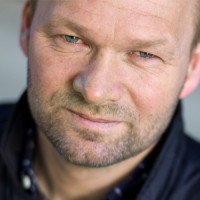First Arctic Biology internship students at UNIS have reached the end of their period

Top: DIKU convention Bergen, Dagny at the lab. Mid: Ingvild at SIOS. Bottom: James at Polar Permaculture, Field work in Adventdalen
This semester, five students participated in the all new course, AB-208 Internship in Arctic Biology. After gaining new knowledge and skills from working at different companies here in Longyearbyen, they are ready to finish up and call it a day.
We were introduced to the students a while ago, but then they knew little about what was about to come. But now they do, and all of them have been blogging about their experiences and we will now take a quick look at how it went with the different students.
Polar permaculture – James
First, we have James, a biology student from rural Scotland, who has been tasked with something seemingly impossible. Performing agriculture at a commercial scale in the Arctic, in order to feed the local human population of Svalbard. Or at least give them a nice, fresh salad.
His journey was full of trails and errors. It was not easy finding the optimal conditions for the plants to grow, and when the temperature and moisture conditions in the “greenhouse” varied a lot during the days, it just added to the headache of making these things grow. They did seem to figure it out though, as James has presented us with some photos of spectacularly large and green plants for being in Svalbard.
And not only did he have to grow stuff, he also had to deliver this stuff to restaurants, do tours presenting this stuff for visitors and showing this stuff off on live television! The work of an Arctic farmer is certainly something else.
UNIS Lab Technician – Anna
We now move over to our UiB representative, Anna. She’s been spending her internship assisting the UNIS Arctic Biology departments many lab related needs, but as James, she too had to perform tasks that one would not immediately associate with an internship position.
Anna asked in her blog, what do biologists exactly do? Well, clean is definitely one thing biologist needs to do more of. And Anna has been re-organizing messy samples and equipment that probably have been forgotten for a while. A lab has also a lot of complex machines and one of those, a nutrient analyzer, required lots of love in order to operate properly. She has also helped students with their research projects, been a polar bear guard at field work, extracted DNA, done PCR and nutrient analyzing to name some.
Longyearbyen School – Dagny
Dagny from Bergen and a student of UiB, has been teaching the youth of Svalbard a thing or two about natural science and mathematics. Since Longyearbyen is such a small town, the school here is a bit combined. So, Dagny had to prepare and lead classes with students at different levels in their education. The difference in age and knowledge level, provided an interesting challenge for her and required flexibility. Since Dagny is a scientist in training, she has also done science experiments with the students and had them over at UNIS doing tasks such as dissecting fish.
SIOS – Ingvild
A student from Tromsø, Ingvild, has helped an organization named Svalbard Integrated Arctic Earth Observing System (SIOS). They are located in the Svalbard Science Centre, and deals with creating a system for organizing long term-measurements in the Arctic.
Early in her internship, Ingvild got to travel to Copenhagen where she was helping out organizing a workshop for SIOS. This gave her the opportunity to learn more about what SIOS are doing and learn from those who are collaborating with SIOS.
Since SIOS deals a lot with long-term measurements, they probably have a lot of data. A good chunk of this data was handed over to Ingvild, so she could help convert the data to a more flexible format so that it’s easier for people to use it. Her work at SIOS will therefore probably impact future scientific research!
bioCEED – Simen
Simen, a student from Bodø and native to Bergen, has been working for a familiar organization. bioCEED! At the Arctic Biology Department at UNIS, they are trying to make learning a little better. This will be done by creating an online learning platform (LearningArcticBiologi.info), where the required biological knowledge can be easily accessed by students.
In the beginning, the platform will host content for the AB-201 course, Arctic Terrestrial Biology. Some chapters are already completed, but there still is a lot to go. Since this platform is online, one can now utilize the variety of digital media options out there, like videos! Learning through video is done by millions daily, so Simen have been working on a tutorial style video explaining how to do a floristic analysis, in the field, in the Arctic. He has also made figures, edited text, made coffee, drank coffee, went to the DIKU convention in Bergen and learned about how bioCEED works.
Author: Simen Hjelle


